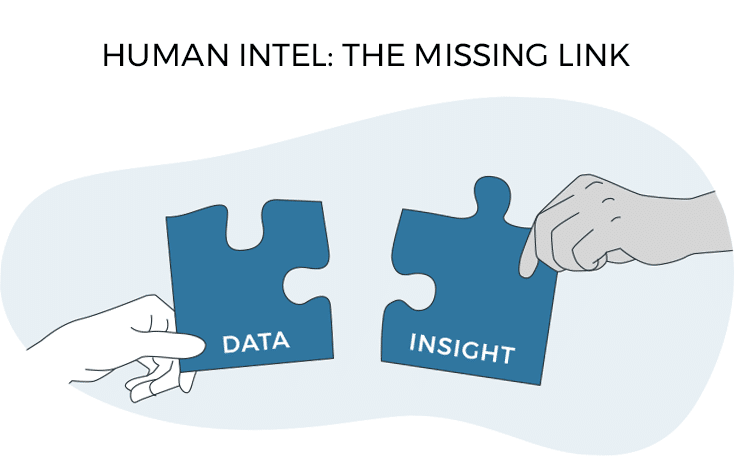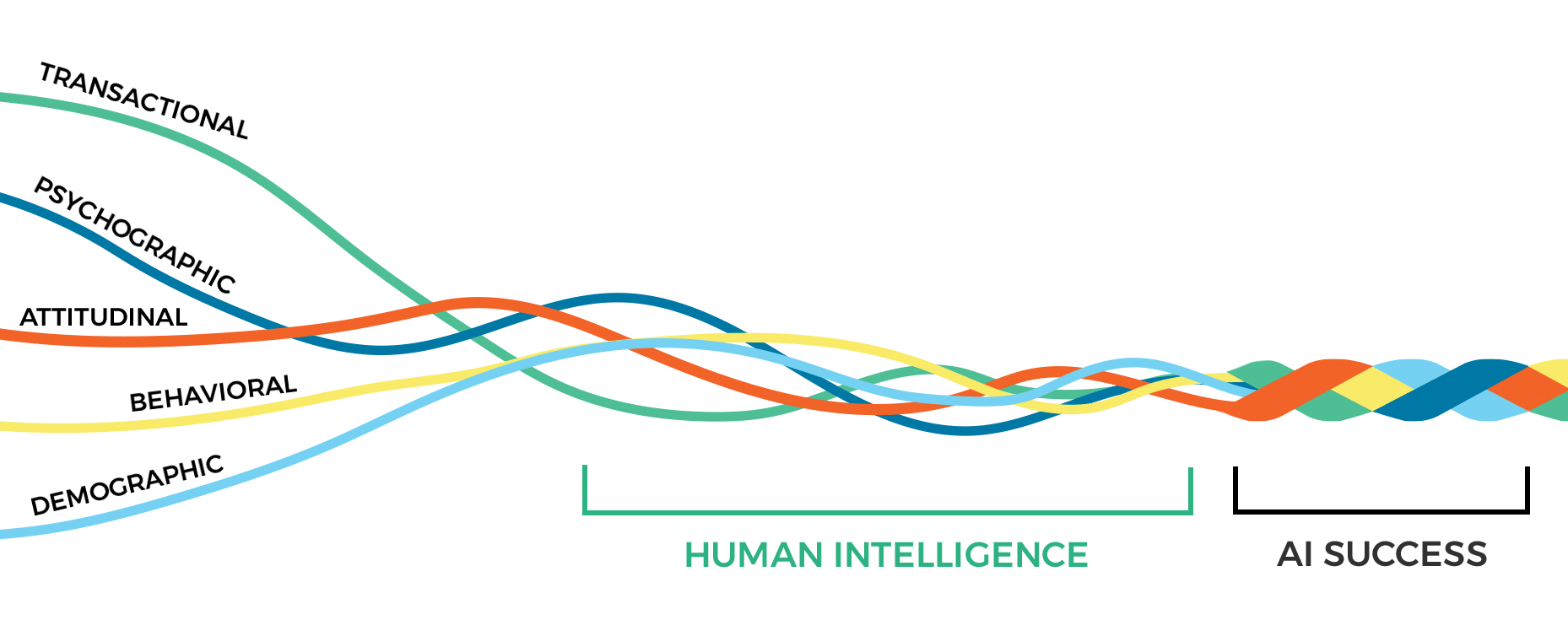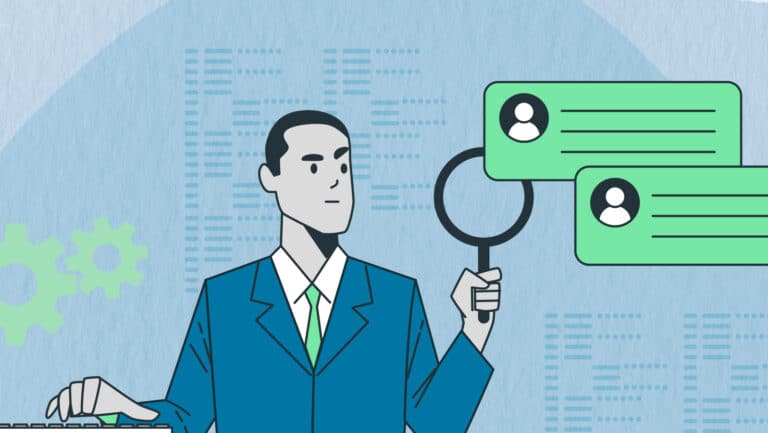executive snapshot
CRM platforms promise clarity, predictability, and growth but for many teams, they’ve become sources of noise, not insight. In this article, we unpack:
- Why the gap between more data and better customer understanding keeps widening.
- How leadership teams can close it by turning everyday conversations into structured, actionable intelligence.
Executives have never invested more in customer data.
C-Suite executives are pouring millions into intelligence platforms, AI-powered CRMs, and customer analytics tools. Every click, every data point, every survey response is captured and categorized.
But somewhere between the data points, the human signals are getting lost.
The irony is frontline teams hear what matters most: the hesitation before renewal, the unspoken frustration in a client call, the shift in tone that signals risk or opportunity. Yet none of it makes its way into sales dashboards or strategy decks.

And that’s where the system starts to break down.
When those human insights aren’t captured, the CRM is left to rely on partial, impersonal data—data that quickly becomes outdated, duplicated, or simply irrelevant to what’s actually happening with customers.
According to Salesforce, 91% of CRM data falls into this category within just one year, turning what should be an insight engine into a repository of stale information.
Where CRMs fall short at delivering intelligence
Too often, companies equate “more inputs” with “better insights.” The reality is that CRMs were never designed to deliver intelligence: they were designed to store information.
From our experience, here’s where the gap shows up:
Built for storage, not understanding
At their core, CRMs are databases. They capture contact info, log calls, store notes, and track deals. That’s valuable but it’s not sales enablement intelligence. Without interpretation, trend recognition, or context, a CRM becomes a digital filing cabinet rather than a decision-enabling tool.
Poor data quality undermines decision-making
Most CRM data is purchased, usage-based, or incomplete. It lacks the critical customer intel like drivers, decision criteria, timing, internal dynamics that only real human conversations can uncover. As a result, even advanced analytics and AI models end up amplifying bad inputs instead of generating clarity.
Lack of contextual analytics
Even with sophisticated reporting dashboards, CRMs rarely translate metrics into meaningful action that drive human behavior. “4 opened emails” doesn’t equal interest in an upsell, nor does it reveal how the customer’s organization views the partnership. Without contextual understanding, insights stay superficial.
Lack of strategy and governance
Many CRMs are set up generically, without a clear definition of what intel truly matters or a playbook for how it should be captured and shared. When contributions go nowhere, participation drops, and valuable insight flow collapses.
insight:
In short, even the most integrated CRM can’t explain what your customers actually think, feel, or need. That’s the human intelligence layer Hi-Q Group helps teams reclaim.
The missing link in CRM insights
Every day, your frontline sales, delivery, and customer success teams engage in conversations that contain far more valuable intel than purchased datasets or AI projections.
These conversations reveal:
- Why a customer is hesitating to renew.
- What hidden priorities are shaping a buying decision.
- How expectations are shifting in real time.
But without a structured way to capture and share this intel, it never makes its way back to your team. Your team members walk away every day with priceless information but it never makes its way into sales discussions or growth planning.

When organizations fix this, the results are transformative.
dig deeper
You’ve invested in the tools, the data, and the dashboards.
Yet clarity on customer behavior still feels out of reach.
Our CRM Intel Assessment helps leadership teams pinpoint where valuable
customer insights are getting lost, and which fixes will deliver the fastest impact.
What it takes to turn CRM from a data repository = insight engine
A successful CRM isn’t defined by how much data it stores or how advanced its AI platform is. It succeeds when the human systems behind it are aligned to generate and apply insight.
Employee skills
Train customer-facing teams to listen actively, probe deeper, and capture contextual intelligence from every conversation. These skills transform surface-level interactions into strategic intel moments.
Process and governance
Establish clear frameworks for documenting, sharing, and collaborating on intel. Make insight capture a defined process and responsibility, not an optional task, and ensure teams know exactly how and where their contributions add value.
Measurement and accountability
Introduce ways to measure intel quality and its business impact. Tools like Hi-Q’s proprietary CRS measurement (Customer Relationship Score) make relationship health visible, helping leaders coach effectively, track intel’s influence on outcomes, and incentivize meaningful contributions.
Growth culture playbook
Build a culture where insight-sharing is celebrated and collaboration is structured. Every customer-facing role should understand how their observations fuel growth and supports the customer. Recognize intel-driven wins publicly to embed these habits across silos.
insight:
In short, technology should amplify human understanding—not replace it. Otherwise, more CRM or AI investments lead to less clarity and more wasted dollars.
case in point:
Industry: Financial (Enterprise Lending & Advisory)
Size: 350M Annual Revenue | 1,800 employees | NA + EU
Challenge: Surface Data ≠ Customer Insights
This client’s leadership realized no amount of additional purchased data or CRM AI upgrades would solve their fundamental insight gaps. Their intel assessment revealed customer-facing teams lacked the skills and processes to capture what truly drove customer decisions and their sales team held what little valuable intel they had in personal documents—rarely if ever shared with the broader team.
Working with Hi-Q Group, they:
- Standardized intel-gathering and sharing processes across divisions
- Delivered training and coaching for deeper client conversations
- Created incentives for documenting intel leading to wins in their CRM
- Built cross-departmental feedback loops to unify customer visibility
As a result, they:
- Increased upsell opportunities in advisory services
- Drove stronger retention across high-value accounts
- Boosted CRM adoption and team confidence in their data
- Improved growth culture with incentive and recognition programs
By shifting focus from more data to better customer conversations, they turned their CRM investment into a true growth engine.
Steps leaders can take to turn customer data into actionable insights
Through our work with Fortune 1000 clients across a variety of markets, we’ve seen that transformation doesn’t begin with technology; it begins with people, processes, and the right governance around intel flow.
Here’s the six-step framework we use to help leaders turn CRMs from static systems of record into engines of organic, actionable insight:

A six-step model for operationalizing customer intelligence that combines
human connection, repeatable processes, and measurable accountability.
Step 1: Identify current intel gaps
Every transformation begins with radical honesty and transparency. Before investing in yet another tool or dataset, leaders must understand where insights are actually breaking down. Most intel gaps stem from silos, inconsistent habits, and shallow customer interactions that rarely if ever turn into shared insight.
This foundational step reveals the blind spots that make CRM data unreliable for insights and uncovers where actionable intel is truly missing.
What to do
- Conduct a CRM intel gap assessment across key dimensions: gathering, sharing, and application.
- Survey customer-facing roles (sales, delivery, etc.) about their confidence in probing customers for more information and escalating insights.
- Analyze CRM data for freshness, completeness, and dependency on purchased vs. organic intel.
Common traps to avoid
- Assuming leadership perceptions match frontline reality—they rarely do.
- Focusing only on data volume rather than insight quality.
- Skipping cross-functional input, which keeps silos intact.
Impact
This step turns guesswork into a measurable baseline — it shows leaders where “broken intel flow” is costing them growth.
✦ CRM Intel Assessment: Pinpoint your intel gaps to improve actionable intelligence. ⇢
Step 2: Build foundational relationship skills
Most CRM challenges start with human conversations. When sales, delivery, or customer success teams aren’t equipped to probe deeply or listen for intent, valuable intel never makes it into the system.
Empowering these roles with relationship and listening skills transforms every interaction from a transaction into a moment of discovery.
What to do
- Deliver practical training and roleplays focused on uncovering decision drivers, shifting priorities, and stakeholder dynamics.
- Teach emotional intelligence as a business skill—reframing intel-gathering as customer advocacy, not “pushy” sales-focused interrogation.
- Tailor sessions for different functions so training feels relevant, not generic.
Common traps to avoid
- Treating training as a “one and done” event without reinforcement.
- Overlooking role-specific challenges, like delivery teams’ execution focus and KPIs over intel.
- Ignoring cultural resistance, leading to low adoption of new skills.
Impact
Once people see intel as part of customer care, not compliance, adoption changes overnight.
Step 3: Implement repeatable engagement and intel processes
Insight without process dies in silos. To make intel sustainable, organizations need simple, repeatable frameworks for capturing, sharing, and applying what’s learned in every interaction.
This is where structure replaces chaos and where CRM finally becomes a living system instead of a data graveyard.
What to do
- Develop standardized engagement protocols for capturing priorities and intent.
- Establish cross-departmental sharing rhythms (joint reviews, shared dashboards, recurring syncs).
- Reward intel contribution through recognition and incentives tied to collaboration.
Common traps to avoid
- Creating processes without buy-in, resulting in “black hole” intel that gets ignored.
- Overengineering workflows that teams inevitably bypass.
- Neglecting CRM integration, causing duplication and frustration.
Impact
Repeatable processes turn insight capture into a daily habit, not a quarterly initiative.
✦ CRM Intel Assessment: Pinpoint your intel gaps to improve actionable intelligence. ⇢
Step 4: Apply an account-based growth strategy
Intel scattered across all accounts wastes effort and dilutes impact. An account-based approach focuses resources on high-value relationships, using targeted intel to uncover risks and opportunities where they matter most—turning CRM from a broad repository into a precision tool for expansion and revenue.
This is where strategy replaces scattershot tactics, prioritizing deep insights on key clients to drive sustainable wins instead of chasing every lead.
What to do
-
Identify and prioritize high-value accounts based on revenue potential, strategic fit, and initial intel scans.
-
Develop personalized engagement plans with tailored intel protocols for capturing priorities, pain points, and intent.
-
Align cross-functional efforts with incentives to collaborate on account-specific growth actions.
Common traps to avoid
- Prioritizing too many accounts, spreading resources thin and reducing focus on top opportunities.
- Relying on gut feel without objective criteria like CRS, leading to misaligned strategies.
- Neglecting ongoing iteration, allowing plans to stagnate amid shifting customer needs.
Impact
Account-based growth ensures intel doesn’t sit in reports. Instead, it drives decisions, actions, and measurable revenue.
An account-based strategy transforms intel into focused growth, accelerating expansions and revenue by 20-30% through proactive, measurable wins on your most valuable clients.
Step 5: Introduce CRS measurement and Growth Playbook™
Every transformation begins with radical honesty and transparency. Before buying another tool or dataset, leaders must understand where insights are actually breaking down. Most intel gaps stem from silos, inconsistent CRM habits, and shallow customer interactions that never turn into shared insight.
This foundational step reveals the blind spots that make CRM data unreliable and uncovers where actionable insight is truly missing.
What to do
- Conduct a CRM intel gap assessment across key dimensions: gathering, sharing, and application.
- Survey customer-facing roles (sales, delivery, business development) about their confidence in probing and escalating insights.
- Analyze CRM data for freshness, completeness, and dependency on purchased vs. organic intel.
Common traps to avoid
- Assuming leadership perceptions match frontline reality — they rarely do.
- Focusing only on data volume rather than insight quality.
- Skipping cross-functional input, which keeps silos intact.
Impact
This step turns guesswork into a measurable baseline — it shows leaders where “broken intel flow” is costing them growth.
✦ CRM Intel Assessment: Pinpoint your intel gaps to improve actionable intelligence. ⇢
Step 6: Iterate and scale across your organization
Transformation isn’t a one-off project; it’s an ongoing activity. Once the framework works within pilot teams, the next phase is scaling it across the organization with regular reviews, continuous feedback, and a culture that celebrates insight-driven wins.
What to do
- Run periodic intel audits and collect feedback to refine each process.
- Scale what works across regions or business units.
- Highlight wins (like account expansions or renewals) tied to intel and develop internal champions to reinforce adoption.
Common traps to avoid
- Declaring victory too early. Culture shifts take time.
- Expanding too fast before foundational behaviors stick.
- Measuring only operational metrics, not cultural progress.
Impact
When this becomes part of “how we do business,” CRM finally evolves from a reporting tool to a strategic growth engine.
Get back to the basics of growth
It’s easy to believe the answer lies in bigger budgets for data, AI, or the latest intelligence platforms and software vendors are happy to reinforce that belief.
But the truth is simpler:
Meaningful conversations = meaningful insights.
When customer-facing teams know how to listen, interpret, and share insights, your CRM finally does what it’s meant to: drive pipeline, retention, and long-term growth.
take it further
You now know what a high-performing intel flow looks like,
but how close is your organization to achieving it?
Our CRM Intel Assessment helps leadership teams benchmark their
current state and pinpoint where to start building true customer intelligence.
You now know what a high-performing intel flow looks like, but how close is your organization to achieving it?
Our CRM Intel Assessment helps leadership teams benchmark their
current state and pinpoint where to start building true customer intelligence.

WHAT’S UP NEXT:
Learn why most AI-CRM projects fail and how to fix data,
process, and culture gaps to make your CRM truly AI-ready.
Learn why most AI-CRM projects fail and how to fix data, process, and culture gaps to make your CRM truly AI-ready.
TOP LEADERSHIP QUESTIONS
HOW TO CONVERT CUSTOMER DATA INTO ACTIONABLE INSIGHTS?
Converting customer data into actionable insights requires a structured approach that blends data analysis with human-sourced intelligence to ensure relevance and impact. In B2B environments, where customer behavior is complex and influenced by multiple stakeholders, leaders often rely on diverse data sources like transaction records, usage patterns, and purchased datasets.
However, without incorporating organic intel from direct customer conversations—such as priorities, pain points, and intent signals—the process falls short, leading to incomplete insights that fail to drive business outcomes.
The key is to start with robust data collection from frontline roles (sales, delivery, business development) to capture contextual details that analytics platforms alone can’t provide. Human intelligence is often the missing piece for failed CRM and AI deployments.
Training teams to probe deeper turns superficial data into actionable data, by enriching CRM tools with the qualitative depth they need for powerful, deeper insights. And it works. Data-driven companies reported 37.7% higher revenue growth compared to “intuition-driven” competitors.
WHAT IS AN ACTIONABLE DATA INSIGHT IN B2B?
An actionable data insight in B2B is a precise, context-rich finding derived from customer data that directly informs strategic decisions, enabling teams to take immediate, measurable steps toward business goals. Unlike raw metrics (e.g., email open rates), it’s enriched with human context—like intent signals from sales conversations—to make it relevant and executable. For instance, discovering a customer’s shifting priorities through direct intel isn’t just data; it’s actionable data when it prompts a tailored upsell strategy.
In B2B, where relationships span multiple stakeholders, actionable insights must address customer behavior and drivers, often blending transaction data with qualitative intel to predict outcomes. Without organic human intelligence, insights remain superficial, failing to impact decision-making or customer retention.
Ultimately, it’s insight that drives action—turning business intelligence into competitive advantages like improved forecasting and retention.
HOW CAN LEADERS IMPROVE THEIR CRM INSIGHTS?
Leaders can improve CRM insights by shifting from exclusively tool-centric approaches to human-powered intel strategies, ensuring data collection includes organic, conversation-sourced details that reveal true customer motivations. Start by auditing data sources for gaps—most CRMs rely on transaction or purchased data, but lack the “why” from direct interactions, leading to incomplete analytics insights and lower ROI on AI initiatives.
Key actions: Align on intel strategies, apply intel gathering and sharing processes across functions, incentivize intel contributions, and integrate AI tools only after building a strong intel foundation. This elevates CRM from a repository to an insights engine, enhancing predictive analysis and decision-making.
HOW DO ACTIONABLE INSIGHTS FROM DATA IMPACT STRATEGIC B2B DECISIONS?
Actionable insights from data profoundly impact strategic B2B decisions by providing the context needed to align actions with customer needs, driving better business outcomes like revenue growth and retention.
In B2B, where deals involve complex stakeholder dynamics, insights enriched with human intel (e.g., from probing conversations) reveal drivers beyond transaction data, enabling personalized strategies that reduce risks and seize opportunities.
Benefits include:
- Enhanced market understanding and opportunity identification
- Improved customer-centric strategies
- Risk mitigation and informed forecasting
- Operational efficiency and resource allocation
- Competitive edge through sustained growth
WHAT ARE THE KEY STEPS IN CONVERTING DATA INTO ACTIONABLE INSIGHTS?
When you find limited ROI on your CRM or AI investments, it’s often not due to a lack of more data, but a lack of a human intelligence layer which should be driven by frontline roles. These are customer-facing roles, often including sales, delivery and support functions, who pick up key pieces of valuable intel in their interactions with customers.
Often, teams simply lack an intel strategy, processes, and incentives needed for consistent intel collection and collaboration. To fix this issue, follow these 6 critical steps:
- Assess Current Intel Gaps: Use an Intel Assessment to identify deficiencies in data collection and quality. Often, leaders will find their teams avoid using their CRM entirely for customer data, due to poor data quality and lack of reciprocity/incentives.
- Build Foundational Relationship Skills: Train frontline teams to enrich data with context from interactions. Use roleplays for probing drivers and priorities; teach emotional intelligence; tailor for roles. Teams need to understand how to listen for key intel, and how to probe deeper for understanding and opportunity identification.
- Implement Repeatable Intel Processes: Create repeatable processes for intel collection and collaboration. What to do: Standardize protocols; set up incentives and accountability. This ensures your frontline roles understand their responsibility and process for gathering valuable customer intel needed for actionable insights.
- Apply Account-Based Growth Strategy: Focus on high-value accounts to customize intel strategies. What to do: Prioritize accounts by revenue and risk so teams can customize their intel and engagement strategies where it matters most.
- Introduce CRS Measurement and Coaching: Quantify relationships for actionable guidance. What to do: Roll out CRS reporting, ideal for complex B2B sales cycles. This provides a more realistic snapshot of customer relationship quality on high-value accounts to understand risk and growth opportunities. Hi-Q Group’s proprietary CRS framework provides coaching guides for managers to guide team members on low scores for improvement and accountability.
- Iterate and Scale: Refine continuously for sustainability. What to do: Audit regularly; scale with feedback; celebrate wins. This creates an insights-rich organization focused on growth through customer engagement.
WHY IS AN ACCOUNT-BASED GROWTH STRATEGY SO EFFECTIVE IN FINDING ACTIONABLE INSIGHTS IN B2B?
An account-based growth strategy is highly effective in finding actionable insights in B2B because it focuses resources on high-value relationships, enabling deeper, targeted intel capture that reveals nuanced drivers and opportunities—far beyond broad data sweeps. By prioritizing key accounts based on revenue potential or strategic fit, teams can probe for specific intel like shifting priorities or stakeholder dynamics, turning conversations into precise, actionable data.
Hi-Q Group pairs this with their proprietary CRS (Customer Relationship Score) measurement for accountability, ensuring insights inform personalized strategies that boost customer retention and expansion. Forrester reports B2B firms using account-based approaches see 10% higher win rates, as it aligns intel with business objectives.
Unlike scattered efforts, it fosters collaboration across sales/delivery, amplifying AI tools with human context for superior business outcomes and customer experience. In insights-rich organizations, this strategy accelerates decision-making and predictive analysis, making CRM a true growth engine.












